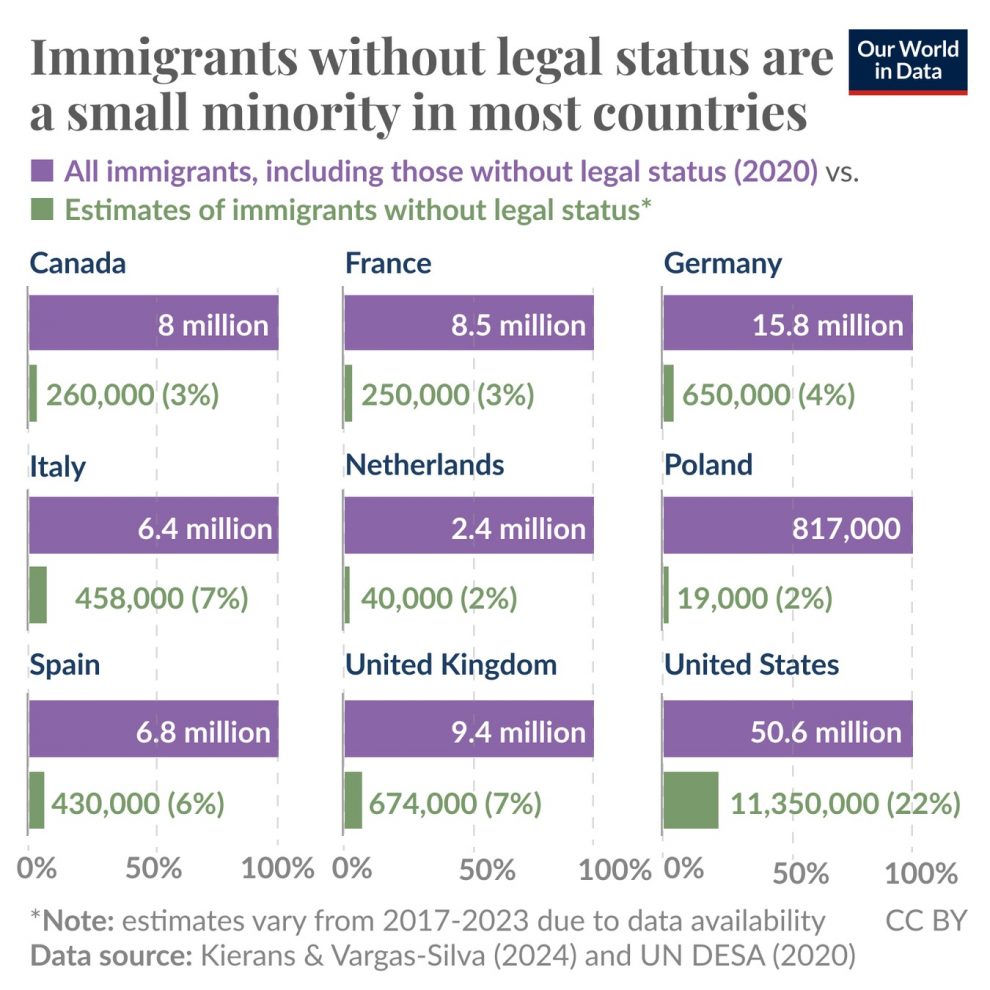According to new data, undocumented immigrants represent a minor segment of the overall immigrant population in most affluent nations, with 22% in the United States and significantly lower percentages in the United Kingdom (7%) and Germany (4%).
Findings from the Measuring Irregular Migration (MIrreM) project highlight that undocumented immigrants constitute a relatively small fraction of the total immigrant population in affluent nations, with figures such as 7% in the United Kingdom, 4% in Germany, and under 2% in the Netherlands. In contrast, the United States exhibits a much larger proportion, where approximately 22% of its immigrant population is undocumented. These insights underline the need for reliable data to accurately assess immigration issues and support the formulation of thoughtful, compassionate policies that cater to the complexities of undocumented migration.
Undocumented Immigrants Make Up a Small Fraction of the Total Migrant Population in Developed Countries
In a world where immigration is a highly politicized topic, understanding the true scope of undocumented immigrants offers critical perspective. Contrary to common perception, immigrants lacking legal status actually constitute only a small fraction of the overall immigrant population in most affluent nations. New findings from the Measuring Irregular Migration (MIrreM) project highlight these nuances and offer a clearer picture of the undocumented population across different countries. The study emphasizes the importance of accurate data and provides specific percentages to quantify the presence of undocumented migrants in developed countries.
Numbers Reveal a Different Reality
In countries like the United Kingdom, Germany, and the Netherlands, where immigration issues are often central in political debates, immigrants without legal status make up a surprisingly small portion of the total immigrant population. According to the MIrreM project’s latest estimates (covering one specific year between 2017 and 2023) and cross-referenced with data from the United Nations Department of Economic and Social Affairs (2020), only around 7% of the United Kingdom’s immigrant population lacks legal status. In Germany, this figure is even lower, at just 4%, while the Netherlands records fewer than 2%.
The United States, however, presents a strikingly different picture, where approximately 22% of its immigrant population lacks legal status. This means about one in five immigrants in the U.S. are undocumented — a percentage significantly higher than most other wealthy countries. This unique American situation could be attributed to various factors, including its geographical position, immigration policies, and historical trends.
An Overview of the MIrreM Project
The Measuring Irregular Migration (MIrreM) project, a comprehensive research initiative, seeks to bring reliable data to an often poorly understood area of migration studies. By focusing on undocumented populations, MIrreM allows researchers, policymakers, and the public to gain a realistic understanding of migration flows. The estimates in the study represent findings for a specific year within the 2017 to 2023 period, bringing up-to-date insights that have been carefully cross-referenced with UN data to create the clearest possible picture.
MIrreM’s contributions are significant in that they help disentangle the notion that undocumented immigration is rampant or uncontrollable. By showing that only a small fraction of immigrants in wealthy countries are undocumented, the project encourages policymakers to craft nuanced solutions to immigration issues. Furthermore, the findings challenge the assumption that undocumented migration is widespread and that it constitutes a major segment of overall immigration trends.
The Role of Policy and Geography
The disparity between countries like Germany or the Netherlands and the United States may reflect differences in migration policies, geographical accessibility, and labor market demands. The European Union, for example, has put in place strict immigration controls, as well as mechanisms to address undocumented migration through regularization programs, repatriation efforts, and cooperation with non-EU countries. In the U.K., despite recent changes due to Brexit, immigration policies remain relatively stringent, and undocumented migration remains limited.
The United States, by contrast, shares a vast border with Mexico and has long been a primary destination for people seeking better economic opportunities. The combination of high demand for labor in sectors such as agriculture, hospitality, and construction, along with complex and sometimes restrictive immigration policies, creates a pathway for many migrants to reside in the U.S. without legal status. However, the U.S. is not alone in dealing with a substantial undocumented population; this phenomenon is present, to a lesser degree, across many wealthy nations, each with its unique contributing factors.
Understanding the Bigger Picture
These findings are essential for understanding migration trends and forming a realistic approach to managing them. The small percentage of undocumented immigrants in most wealthy countries highlights that immigration issues cannot be generalized. Policies shaped by data, rather than rhetoric, can address the specific challenges each country faces while respecting human rights and promoting social cohesion.
A broader view also considers the benefits that migrants, including those without legal status, bring to their host countries. Economists note that immigrants, documented and undocumented alike, contribute significantly to economic growth, cultural diversity, and innovation. Thus, understanding the small scale of undocumented immigration can foster more balanced discussions and discourage narratives that exaggerate the impact of undocumented populations.
Toward Data-Informed Immigration Policy
The MIrreM study’s findings point to the necessity of data-driven policy-making. For countries dealing with higher percentages of undocumented immigrants, such as the United States, immigration reform efforts could benefit from a holistic approach that considers both border security and pathways to legal residency or citizenship. In nations with smaller undocumented populations, efforts may focus on integration, support services, and maintaining effective immigration control measures.
Immigration remains a complex issue, with each country facing unique challenges based on its geography, economy, and policies. The MIrreM project’s statistics show that most immigrants are documented, legally residing in countries where they work, study, and contribute. Moving forward, data such as these should guide policy discussions, helping nations to adopt fair, humane, and practical immigration policies that acknowledge both the needs of migrants and the realities of the host society.
Concluding Thoughts
As immigration continues to shape societies globally, understanding the true scope and scale of undocumented populations is essential. The MIrreM project’s estimates, combined with United Nations data, reveal a compelling truth: in most wealthy countries, undocumented immigrants are a small fraction of the whole. The United States, with its unique situation, presents distinct challenges, yet the fundamental principle remains the same. Countries can foster public understanding and build comprehensive policies by relying on data rather than assumptions, ensuring that their approaches to immigration align with reality and compassion.






